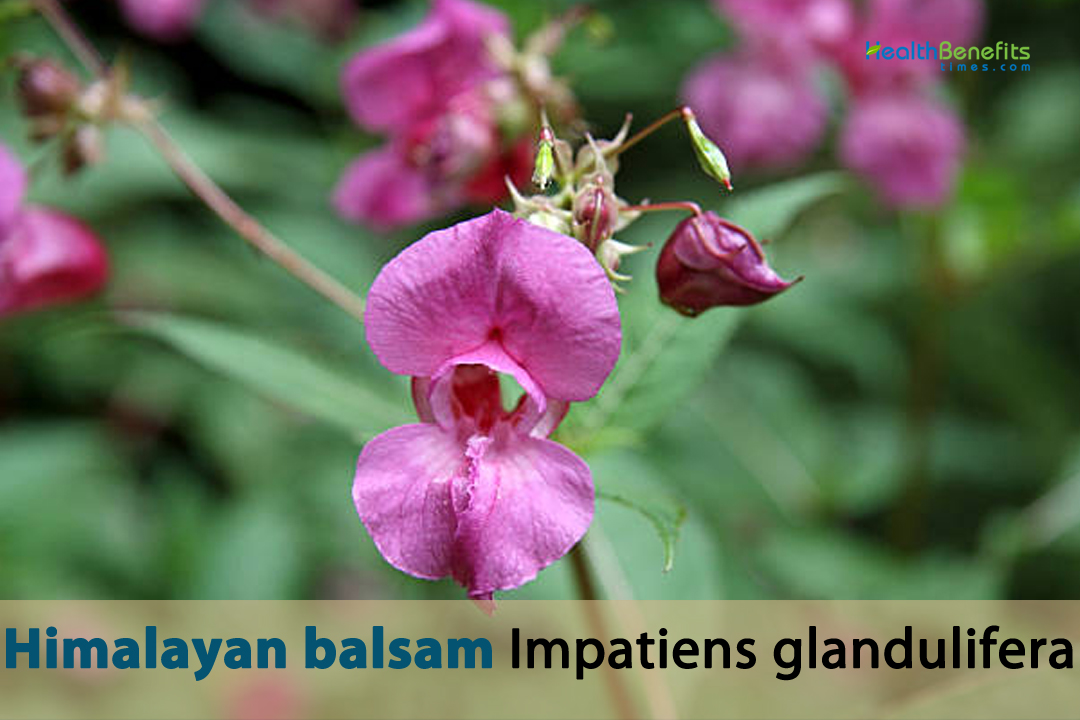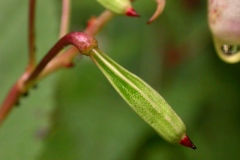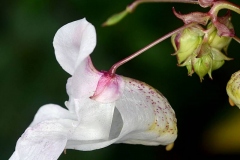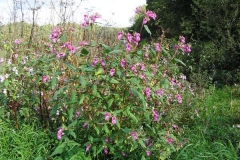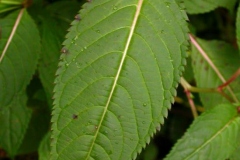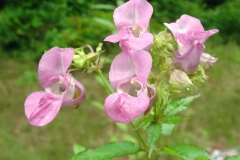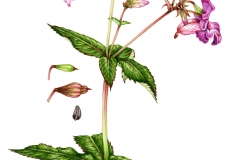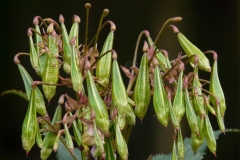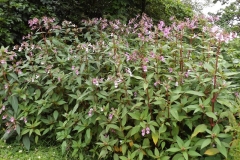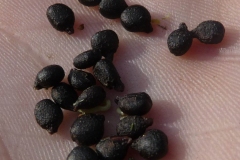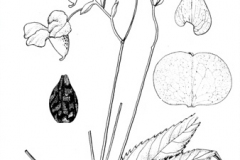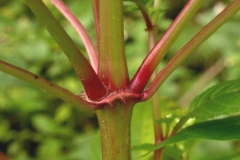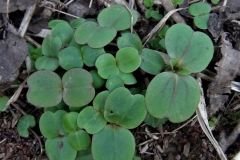| Himalayan balsam Quick Facts | |
|---|---|
| Name: | Himalayan balsam |
| Scientific Name: | Impatiens glandulifera |
| Origin | Foothills of the Himalayan region of Asia, specifically India, Pakistan, Nepal, Bhutan, and Tibet |
| Colors | Initially green and gradually mature to a brown color |
| Shapes | Five chambered capsules that measures about 3-5 cm long and up to 1.5 cm wide |
| Taste | Generally considered bland or lacking in flavor |
| Health benefits | Beneficial for skin disorders, back pain, rheumatism, urinary tract infections, hematuria, burns, fractures, snake and bug bites, bacterial and fungal illnesses |
| Name | Himalayan balsam |
|---|---|
| Scientific Name | Impatiens glandulifera |
| Native | Himalayan region of Asia, specifically India, Pakistan, Nepal, Bhutan, and Tibet. However, it has been introduced to many other parts of the world, including Austria, Belgium, Bulgaria, Canada, Croatia, Czech Republic, Denmark, Estonia, Finland, France, Germany, Hungary, Ireland, Liechtenstein, Lithuania, Luxembourg, Montenegro, Netherlands, New Zealand, Norway, Poland, Romania, Serbia, Slovakia, Spain, Sweden, Switzerland, Ukraine, United Kingdom, United States |
| Common Names | Himalayan Balsam, Indian Balsam, Policeman’s Helmet, Kiss-me-on-the-mountain, Gnome’s Hatstand, Bobby Tops, Copper Tops, Ornamental Jewelweed, Pink Peril, Pink Lady, Jumping Jack, Poor Man’s Orchid, Touch-me-not, Lady’s Slipper, Queen’s Slipper, Himalayan Touch-me-not, Indian Jewelweed, Impatiens, Himalayan Snapweed, Wild Impatiens, Balsamine, Indian Balsamwort, Garden Balsam, Giant Balsam, Exotic Impatiens, Tramp’s Trouser, Patient Lucy, Wounded Impatiens, Pink Fountain, Soldier’s Orchid |
| Name in Other Languages | Bulgarian: Zhlezista slabonoga (Жлезиста слабонога) Catalan: Balsamina glandulifera Chinese: Xǐmǎlāyǎ fèngxiānhuā (喜马拉雅凤仙花), Xiàn bǐng fèng xiān huā (腺柄凤仙花) Cornish: Basnet gwithyas Croatian: Nedirak Czech: Netýkavka žláznatá, netýkavka Royleova Danish: Kæmpe-balsamin, Himalayabalsam, Bakke-Jordbær, Have-Jordbær, Royles balsamin, Spansk Jordbær Denmark: Kæmpe-balsamin, kjempespringfrø Dutch: Reuzenbalsemien, Himalayabalsem, Springbalsemien, English: Himalayan balsam, Himalayan touch-me-not, policeman’s helmet, Indian balsam, Ornamental Jewelweed, Purple Jewelweed, Glandular Touch-Me-Not, custodian helmet, touch-me-not, Washington orchid, Jewelweed Policeman’s-helmet, Policeman’s-Helmet, kiss-me-on-the-mountain Estonian: Verev lemmalts, Impatiens roylei Finland: Jättipalsami Finnish: Himalajanpalsami, Karvamansikka, Puutarhamansikka, Ukkomansikka, Jättipalsami French: Balsamine de l’Himalaya, balsamine glanduleuse, balsamine géante, impatiente glanduleuse, Balsamie de l’Himmalaya, Balsamine de lhimalaya, balsamine géante German: Drüsenspringkraut, drüsentragendes Springkraut, drüsiges Springkraut, indisches Springkraut, Riesenspringkraut, Druesiges Springkraut, Drüsiges Springkraut, Indisches Springkraut, Emscherorchidee, Wupperorchidee Hungarian: Bíbor nebáncsvirág Iceland: Risalísa Irish: Lus na pléisce Italian: Balsamina dell’Himalaya, balsamina ghiandolosa, impaziente ghiandolosa, Impaziente ghiandulosa Japanese: Himaraya barusamu (ヒマラヤバルサム) Korean: (Himalaya byeolcheonji (히말라야 별천지) Latvian: Puķu sprigane Lithuanian: Bitinė sprigė Luxembourgish: Drüse-Sprangkraut Malayalam: Himaalayan baalsam (ഹിമാലയൻ ബാൽസം) Netherlands: Balsemien, reuzen Norwegian: Himalayabalsam, Hage-Jordbær, Moskusjordbær, Nakkebær, Kjempespringfrø, kæmpe balsamin Polish: Niecierpek gruczołowaty, niecierpek Roylego, Balzamka himalajska, niecierpek himalajski Portuguese: Bálsamo-do-Himalaia, beijo Russian: Gimalayskaya bal’zamina (Гималайская бальзамина), bal’zamin zhelezistyy (бальзамин железистый), bal’zamin zhelozkonosnyy (бальзамин желёзконосный), nedotroga zhelezistaya (недотрога железистая), nedotroga zhelozkonosnaya (недотрога желёзконосная), nedotroha Roylya (недотрога Ройля) Slovak: Netýkavka žliazkatá Slovene: Zlezava nedotika Spanish: Bálsamo del Himalaya, impaciencia, žlezava nedotika Swedish: Himalayabalsamin, jättebalsamin, Backsmultron, Jordgubbe, Parksmultron, Scharlakanssmultron, Jättipalsami Ukrainian: Rozryv-trava zalozysta (розрив-трава залозиста) Upper Sorbian: Wysoki pryskawc USA: Ornamental jewelweed Welsh: Cap Dur Heddwas, Ffromlys Chwarennog, Jac y neidiwr |
| Plant Growth Habit | Tall, annual, glabrous, broadleaved, herbaceous plant |
| Growing Climates | Grows in riparian areas, wet meadows, swamps, moist forests, forest edges, floodplain forests, stream sides, roadside, ditches, gardens, yards, parks, rivers, riverbank |
| Soil | Prefers fertile soils that are rich in nutrients. It can grow in a wide range of soil types, including clay, loam, and sandy soils. |
| Plant Size | Up to 2 to 3 meters (6.5 to 10 feet) |
| Root | Made of fibers and have many branches. They make a thick network in the soil of thin structures that look like threads and go both horizontally and vertically |
| Stem | Erect, hollow, smooth, hairless, reddish, and multi-branched with large, swollen nodes |
| Bark | Relatively thin and smooth. Surface is typically glossy or slightly waxy in nature |
| Leaf | Large, simple, ovate to elliptic, 15 cm long, 7 ½ cm wide, and opposite (although they occasionally form whorls of 3) with sharply toothed margins |
| Flowering season | Summer to fall (May to October) |
| Flower | Flowers have a unique shape, often described as spurred or slipper-shaped. They resemble a trumpet or cone with a curved upper lip and a downward-facing lower lip |
| Fruit Shape & Size | Five chambered capsules that measures about 3-5 cm long and up to 1.5 cm wide, when mature it explode expelling seeds forcefully |
| Fruit Color | Initially green and gradually mature to a brown color |
| Seed | Large, 4-7 mm long and 2-4 mm wide with a mean weight of 7.32 mg |
| Flavor/Aroma | Strong musty smell |
| Taste | Generally considered bland or lacking in flavor |
| Plant Parts Used | Roots, leaves, sap, flower, seeds |
| Propagation | By Seed, Stem Cuttings, Division and Self-Sowing |
| Lifespan | Within a single growing season |
| Season | September to November |
| Varieties |
|
| Health Benefits |
|
| Other Facts |
|
Plant Description
Himalayan balsam is a tall, annual, glabrous, broad-leaved, grass plant that usually grows up to 2 to 3 meters (6.5 to 10 feet) tall. The plant grows in riparian areas, wet meadows, swamps, moist forests, forest edges, floodplain forests, stream sides, roadside, ditches, gardens, yards, parks, rivers, riverbanks, ponds, canals, wetlands, grasslands, shrubbery, hedgerows, abandoned fields, or places where vegetation has been cleared. The plant likes to grow in dirt that has a lot of nutrients. It can grow in many different kinds of dirt, like clay, loam, and sand. But it likes dirt that is moist but has good drainage. Compacted soils can make it hard for roots to grow and for plants to get water and nutrients. For good root growth, it’s important to make sure the soil is loose and crumbly. This plant comes from the Himalayas, and it is known for how quickly it grows, how nice it looks, and how tiny its flowers are. But because it is invasive and spreads quickly, it has caused serious biological and environmental problems.
Growing environment of Himalayan balsam
Himalayan balsam thrives in specific growing environments. Here are the key factors that contribute to its preferred growing conditions:
- Moisture: Himalayan balsam favours moist or wet surroundings. It grows most often near rivers, streams, ditches, and other places with a lot of water. The plant has learned to live in these places and can handle being wet for a while.
- Sunlight: Himalayan balsam can grow in some shade, but it grows best in places with partial to full sun. It usually grows in messed-up or open places where there is enough sunlight for photosynthesis.
- Soil: The plant likes to grow in dirt that has a lot of nutrients. It can grow in many different kinds of dirt, like clay, loam, and sand. But it likes dirt that is moist but has good drainage.
- Disturbed Habitats: Himalayan balsam grows most often in disturbed or degraded environments, like along riverbanks, roadside ditches, and in empty fields. It can grow quickly in places where the natural plants have been destroyed or cleared away.
- Temperate Climates: Himalayan balsam is adapted to temperate climes. It can live in a wide range of temperatures, but it does best in places where the weather is warm to moderate. It grows in places with mild temperatures, like Europe, North America, and some parts of Asia.
- Competitive Advantage: Himalayan balsam does well in the area where it grows because it grows quickly and can beat out other plants. Its height and dense foliage block the sun and make it hard for close plants to grow. This lets it take over the available resources.
Roots
Roots are usually made of fibers and have many branches. They make a thick network in the soil of thin structures that look like threads and go both horizontally and vertically. The size of the roots can change based on how old the plant is and where it is in its growth cycle. When the plant is young, the roots are small and weak. As the plant grows older, its root system grows and spreads out to support the plant’s growing size. Most of the time, the roots are shallow and spread out wide near the surface of the dirt. This lets them take advantage of resources quickly. They may also grow deeper taproots that reach deeper into the dirt to get to water and nutrients.
Stem
Stems are usually round and have a smooth surface. It looks straight and tall, and it seems to grow straight up from the ground. Depending on how old and mature the plant is, the size of the stem can change. In general, the mature stems can grow up to 2-3 meters (6-10 feet) tall, or even higher if the circumstances are right. The hollowness of the stem is what makes it stand out. This means that the middle of the stem is empty and only has air in it. The thin stem supports the plant’s structure and keeps it from being too heavy. The green color of the stem comes from the chlorophyll in the plant, which is needed for photosynthesis. But as the plant gets older or starts to dry out, the stem can start to look brown or stiff.
Bark
The top layer of the stem, which is often called the “bark” for ease of use, has the same shape as the stem as a whole. It goes around the stem and supports and protects it. Himalayan balsam has “bark” that is thin and smooth. It doesn’t look like tree bark, which is usually rough and textured. Most of the time, the surface is shiny or slightly slippery. The color of the “bark” can change based on how old and healthy the stem is. When plants are young, the “bark” on the stem is often the same color as the stem itself. As the plant gets older, it may turn dark or look a little bit like wood, especially at the bottom of the stem. Compared to real woody plants, the bark is not very thick. It doesn’t have the same strength and security as traditional bark.
Leaves
Himalayan balsam has big leaves that look like lances or ovals. They have a simple leaf design, which means that each leaf is just one long strip along the stem. There are no leaflets or other parts. Usually, the leaf border, which is the edge of the leaf, is cut or toothed. It has small, sharp, and crooked teeth along the edges of its leaves. The lines in the leaves are easy to see. From the central vein (midrib), the main veins branch out into secondary veins, making a pattern that looks like a network. Some of the leaves can be pretty big. They are usually between 5 and 15 centimeters (2 to 6 inches) long and between 2 and 7 centimeters (0.8 to 2.8 inches) wide. But the size can change based on things like how old the plant is and how the surroundings is.
Healthy leaves are usually a bright green color, which is a sign of good health. The top side of the leaves is usually smooth, while the bottom side may have a few hairs. The leaves of Himalayan balsam are grouped in a way that makes them look like they are switching places. This means that each leaf is on a different part of the stem, and as the leaves go up, they switch places.
Flower
Himalayan balsam has groups of flowers at the very top of its stems. These groups of flowers, called racemes, can have anywhere from five to twenty blooms per raceme. The flowers have a unique form that is often called slipper-shaped or spurred. With a curved top lip and a lower lip that points down, they look like a trumpet or cone. The lower lip is long and makes a sharp point. Compared to the size of the plant as a whole, the flowers are pretty big. Including the spur, they are about 2 to 4 centimeters (0.8 to 1.6 inches) long on average. Most of the time, the flower is about 2 to 3 centimeters (0.8 to 1.2 inches) across.
Himalayan balsam has flowers that are known for their bright and beautiful colors. The most common color is pink, which can be light pink, dark pink, or even a shade that looks like purple. But you can also find them in white and pale purple. The darker spots on the lower lip of the flowers help insects find the nectar. The flowers have five petals that are grouped in a way that is symmetrical. The upper lip has two petals, while the lower lip has three, with the middle petal making the spur. The flowers are fairly wide and look a little bit like they have fringes or waves on them. Most flowers bloom from late spring to early fall, with the most flowers in summer.
Fruits
Fertile flowers are followed by fruits that are long and cylindrical. It looks like a thin pod or cylinder with sharp ends. The size of the fruit can vary, but it is usually between 2 and 4 centimeters (0.8 and 1.6 inches) long on average. The fruit is usually between 1 and 1.5 centimeters (0.4 and 0.6 inches) wide. The fruit has several chambers or sections, and each one has more than one seed. When the fruit is fully grown, it dries out and gets stiffer.
Himalayan balsam’s mature fruit has rapid dehiscence, which means it can burst open and forcefully throw out its seeds if it is touched or moved. With this system, the plant can spread its seeds over a large area. When the fruit is young, it is usually green. As it ripens, it goes brown or tan. The dry, ripe fruit feels like paper.
Seeds
Most of the time, the seeds are long and flattened. They are oval or kidney-shaped, with one side that is a little bit flatter than the other. The size of the seeds isn’t too big. The seeds are usually between 2 and 3 millimeters (0.08 and 0.12 inches) long. Most of the time, they are between 1 and 2 millimeters (0.04 and 0.08 inches) wide. Most of the time, the seeds are brown, but they can also be light brown, dark brown, or even black. The color can be affected by things like how old the plant is and how the surroundings is.
The smooth, shiny coat that protects seeds is called the seed coat. The seeds may look a little smooth or shiny on the outside. Himalayan balsam is well-known for making a lot of seeds. The plant can quickly spread to new places because it is small and produces a lot of seeds.
Origin and Distribution
Himalayan balsam, which is also called Impatiens glandulifera, comes from the Himalayas in Asia. It was brought to Europe in the early 1800s as a decorative plant because its pink or purple flowers looked nice. Since then, it has spread to many places around the world, including parts of Europe, North America, New Zealand, and other places. Today, you can find it in places like the UK, Canada, the US, and some parts of Asia.
Varieties of Himalayan balsam
There are several varieties or subspecies of Himalayan balsam that are recognized. Here are some of the notable varieties:
- Impatiens glandulifera subsp. glandulifera: This is the most common type of Himalayan balsam and is found in many places. It is known for getting very tall, having bright pink flowers, and spreading quickly.
- Impatiens glandulifera subsp. roylei: The western Himalayas are the home of this subspecies. It has smaller flowers and narrower leaves than the normal Himalayan balsam. It is also shorter than the typical Himalayan balsam.
- Impatiens glandulifera subsp. kashmiriana: This subspecies lives in the part of the western Himalayas called Kashmir. It grows more tightly than a normal Himalayan balsam and has pink or white flowers.
- Impatiens glandulifera subsp. himalayensis: This subspecies lives in the western Himalayas, in places like India’s Himachal Pradesh and Uttarakhand. It grows in a bushy shape and has a lot of pink or white flowers.
- Impatiens glandulifera subsp. nubrica: The Nuristan area in the northeast of Afghanistan is home to this subspecies. It has a shorter height, bigger leaves, and white or light pink flowers.
- Pink-flowered Himalayan Balsam: Himalayan balsam is most often seen with pink flowers. These flowers can be light pink, dark pink, or even a shade between the two. Plants with pink flowers are common and are often linked to Himalayan balsam in general.
- White-flowered Himalayan Balsam: White-flowered Himalayan balsam is less common than pink-flowered Himalayan balsam, but it can be found. Most trees have pink flowers, but these ones have white ones. The difference with white flowers makes the species more interesting.
- Lilac-flowered Himalayan Balsam: Himalayan balsam sometimes has flowers that are the color of lilac. The lilac-flowered variety has flowers that range in color from light lilac to a darker shade of lilac.
- Dwarf Himalayan Balsam: Even though it is not a known variety, there may be some Himalayan balsam plants or groups of plants that are shorter. Most of the time, these plants grow more closely together and are shorter than most plants. You can find the dwarf variation in certain places or as a single outlier in a community.
Health benefits of Himalayan balsam
Himalayan balsam is a plant that grows in the Himalayas. Its scientific name is Impatiens glandulifera. Himalayan balsam has been used in traditional medicine for its possible health benefits, even though it is seen as an alien species in many places. It’s important to remember that there isn’t a lot of scientific study on the healing properties of Himalayan balsam. Most of what we know about it comes from traditional knowledge. Here is some of the detailed health benefits associated with Himalayan balsam:
1. Anti-inflammatory properties
Himalayan balsam has chemicals in it that may help reduce inflammation. Some of these chemicals, like flavonoids and tannins, may help lower inflammation in the body. This could help people with arthritis, joint pain, and skin diseases that make the skin red and swollen.
2. Wound healing
The plant has been used for a long time to help wounds heal. It is thought to have antimicrobial qualities that can help stop infections and help the body heal. Putting a poultice or cream made from Himalayan balsam on small cuts, scrapes, or burns may help protect the area and help it heal.
3. Digestive health
Traditional medicine has used Himalayan balsam to treat stomach problems like indigestion, bloating, and diarrhea. It is thought to have a calming effect on the digestive system, which could help relieve pain and make digestion better.
4. Respiratory support
Himalayan balsam has been used in the past to treat things like coughs, colds, and asthma that affect the lungs. It is thought to have expectorant qualities, which could help loosen mucus and phlegm and make it easier to cough up.
5. Stress reduction
Himalayan balsam has been used for a long time as a natural way to treat nervousness and stress. It is thought to have relaxing effects that can help calm the mind and make you feel better. Some people drink Himalayan balsam tea or use it in massage because it might help them feel calm.
6. Pain relief
Himalayan balsam is sometimes used to relieve pain in traditional medicines. It is thought to have pain-relieving qualities that could help with muscle aches, joint inflammation, and headaches, among other types of pain. But there aren’t many scientific studies on this topic, so more research is needed to figure out how well it works.
7. Antimicrobial activity
Some of the compounds in Himalayan balsam have antimicrobial qualities that can help stop the growth of microorganisms. This shows that it could be used to fight certain infections, but more research is needed to find out how well it works and what it can be used for.
8. Antioxidant effects
Studies have shown that Himalayan balsam has antioxidants like phenolic compounds that can help the body get rid of dangerous free radicals. Antioxidants are very important for keeping your body healthy and lowering your chance of getting chronic diseases.
Traditional uses and benefits of Himalayan balsam
- Himalayan balsam has been used in plant medicine because it has many different effects.
- The antimicrobial and anti-inflammatory qualities of the plant’s extract have been used to treat skin conditions, burns, and wounds.
- It has been used to treat skin problems, rheumatism, and infections of the urinary system.
- Leaves are used to treat burns.
- Root juice helps to treat hematuria (blood in the urine).
- Warts and snakebites can be treated with juice from the leaves.
- Burns can be treated with flower juice.
- People in Asia have used the plant as a natural cure for arthritis, broken bones, and other health problems.
- The flowers can be ground into a paste that can be used to treat burns.
- It can also be used to treat gout and is good for digestion.
- In China, pregnant women use powdered balsam seeds to help them give birth.
- Seeds are also used to treat back pain in the Philippines.
- A paste made from balsam leaves can be used to treat bites from snakes and bugs.
- People also think that the paste can help people cough and can be used to treat cancer.
- Balsam flowers can be used to treat illnesses caused by germs and fungi.
Culinary Uses of Himalayan balsam
Himalayan balsam is an invasive plant species native to the Himalayan region. While it is considered a nuisance in many areas due to its rapid growth and ability to outcompete native plants, there are some culinary uses for Himalayan balsam. Here are a few examples:
- Herbal Tea: Himalayan balsam’s flowers and leaves can be used to make a plant tea. Just put the fresh or dried flowers and leaves in hot water for a few minutes, rinse, and enjoy. The tea has a mild, floral taste and is often used to calm and settle people.
- Salad Ingredient: Himalayan balsam’s young buds and leaves can add a unique flavour to salads. They taste a little bit like arugula or watercress, with a tangy and bitter taste. Make sure to pick them while they are still young and before the plant flowers, because older leaves can get tough and fibrous.
- Jam and Jelly: Himalayan balsam’s ripe seed pods can be used to make jams and sauces. The pods have sweet, sticky pulp that holds small black seeds. You can cook the pods with sugar and water to get the pulp out, then squeeze out the seeds and use the liquid as a base for jams or jellies. People often say that the taste reminds them of rhubarb or blueberries.
- Syrups and Cordials: The sweet pulp inside the seed pods can be used to make syrups and cordials, which are similar to jams and jellies. You can mix the pulp with sugar and water, simmer the mixture until it thickens into syrup, and then use it to flavor drinks or sweets. The sauce tastes like fruit and can give your dishes a unique twist.
Different uses of Himalayan balsam
Apart from its culinary uses, Himalayan balsam has been used in various other ways. Here are some different uses of Himalayan balsam:
- Soil Erosion Control: Himalayan balsam is good for stopping soil runoff because it grows quickly and has a lot of plants. The tall stems and lots of leaves help keep the earth in place on riverbanks, slopes, and other places where it is likely to wash away. Planting Himalayan balsam in the right places can keep dirt from washing away and keep the landscapes in these areas from falling apart.
- Bee Forage: Himalayan balsam is a good source of food for bees and other pollinators because its flowers are full of nectar. The plant makes a lot of nectar, which can be used to make honey and help other plants around it get pollinated. But it’s important to weigh its benefits against the fact that it spreads quickly and could hurt local plants.
- Craft and Decorative Purposes: Himalayan balsam has pretty pink flowers that can be used in crafts and as decorations. You can dry and save them to make flower arrangements, wreaths, or projects with pressed flowers. Flowers can be used in many kinds of art because of their interesting shape and bright colors.
- Wildlife Habitat Enhancement: Even though Himalayan balsam spreads quickly, it can give some animals a place to stay and food for a short time. Small animals and birds can hide in its thickets, and both birds and mammals eat its seeds. To keep ecological balance, it’s important to control how far it spreads and give more attention to local plant species.
- Natural Dye: Natural colors can be made from the flowers of the Himalayan balsam plant. By boiling the bright pink flowers, you can get a dye that can be used to color fabrics, yarns, and even handmade paper. It gives off a lovely soft pink color.
- Compost and Mulch: Himalayan balsam can build up a lot of biomass quickly because it grows quickly. When the plant is pulled and composted the right way, it can add nutrients to the waste. The plant parts can also be used as mulch to stop weeds from growing and keep soil moist in flower beds.
- Animal Feed: Himalayan balsam is not good for all animals, but some animals, like goats and horses, can eat it. It is often used as an addition to feed or fodder when there isn’t much else available. But it should be given in small amounts and along with other healthy foods.
- Biofuel Potential: Some study shows that Himalayan balsam could be used to make biofuel. Because it grows quickly and makes a lot of biomass, it could be used to make biofuel. More research is needed to find out if and how well it can be used as an energy feedstock.
Side effects of Himalayan balsam
Himalayan balsam is an invasive plant species native to the Himalayas. While it is known for its beautiful flowers, it can have negative ecological impacts and cause various side effects. Here are some of the side effects associated with Himalayan balsam:
- Ecological Impact: Himalayan balsam is seen as an invading species in many places where it doesn’t grow naturally. It grows quickly and forms thick stands that can crowd out native plants. This can cause native plant species to be pushed out of their homes, lowering biodiversity and upsetting local ecosystems.
- Reduced Light Availability: Himalayan fir can grow up to 3 meters (10 feet) tall. Because of this, it can grow in large groups that make it hard for other plants to grow. This makes it harder for local plants and animals to grow, which adds to the loss of biodiversity.
- Disruption of Pollination: Himalayan balsam has big, beautiful flowers that bees and butterflies visit to pollinate, but its nectar is not very good for you. This can make pollinators stay away from native plants, which hurt the rate of pollination and make it harder for other plant types to reproduce.
- Habitat Alteration: Dense stands of Himalayan balsam can change the shape and make-up of plant communities, which can change habitats. This can make it harder for local wildlife to find food and shelter, which could cause some species to lose population.
- Management Challenges: Himalayan fir can be hard and expensive to control. It is hard to get rid of because its powerful way of spreading seeds makes it easy for it to spread quickly. Because of this, managing and getting rid of this invasive species often needs long-term plans and the cooperation of many different groups.
Prevention
Himalayan balsam is an annual plant, so the most important thing to do to get rid of it is to use up all of its seeds. This is done by removing the adults over and over again before they have babies. The life of a seed bank is about two years, and control programs should be done for the whole two years. After that, a five-year tracking program should be done. To stop erosion, it may also be necessary to think about a bankside rehabilitation scheme.
Physical Control
Hand pulling is a good way to get rid of adult plants in small areas, and it is better for the earth than using chemicals. Care should be taken to get rid of the whole plant, since plants can grow back in the same season if they are cut but not taken out completely.
You can also get rid of it by cutting it or letting animals eat it. However, you shouldn’t try to cut it after the seed heads have grown, because that would spread the plant. As cut plants can grow back, there should be constant tracking to stop them from spreading seeds. The first tracking visit should happen soon after the Himalayan balsam has been cut down, because it has been known to grow back within a few weeks.
Chemical Control
It can be used for big groups of people who live close together. Note that you can’t use herbicides near a waterway without first getting written permission from SEPA, unless you’re trying to get rid of invasive species. Getting rid of the plant with chemicals can take up to two years.
Cultural Control
Himalayan fir is not resistant to grazing or cutting. Grassland won’t be invaded if the land is used in the same way it has always been used. Mowing and grazing can also get rid of existing infestations, but this needs to be done every year and on a catchment-wide basis.
Mechanical Control
Himalayan balsam is easier to control than permanent invasive plants because it only lives for one year and grows in small patches. The goal of any control must be to stop the plants from making seeds. Mechanical control works best late in the season, when the plants are already in bloom or just starting to bloom. If you cut the trees early below the first node, you can control the population, but it takes a lot of work. Several mechanical methods have been tried in Germany (Hartmann et al., 1995), and they have all been successful. These methods include mowing with or without removing the plant material, mulching, and soil cultivation. When the land is big enough and the conditions are right, farm equipment can be used. Heavy machinery will damage the soil in places where it is wet and soft, leaving open areas that are good for replanting. Smaller stands can be cut with hand-held brush cutters, and the plants can also be pulled out by hand. In this case, it’s important to make sure that the plants you pull don’t have a chance to grow back where you put them down. For long-term success, the area should be watched to see if it starts to come back.
Integrated Control
Integrated control should try to get the best control result while causing the least harm to the environment. Because seeds move down a river, control methods in a river’s catchment area must begin in the upper reaches and move down the river. But this is often difficult because land is owned by different people and the costs are too high.
References:
https://en.wikipedia.org/wiki/Impatiens_glandulifera
http://www.theplantlist.org/tpl1.1/record/kew-2862533
https://indiabiodiversity.org/species/show/244637
https://www.flowersofindia.net/catalog/slides/Himalayan%20Balsam.html
https://accs.uaa.alaska.edu/wp-content/uploads/Impatiens_glandulifera_BIO_IMGL.pdf
https://pfaf.org/user/Plant.aspx?LatinName=impatiens+glandulifera
https://gobotany.nativeplanttrust.org/species/impatiens/glandulifera/
https://gd.eppo.int/taxon/IPAGL
https://www.cabidigitallibrary.org/doi/10.1079/cabicompendium.28766
https://www.itis.gov/servlet/SingleRpt/SingleRpt?search_topic=TSN&search_value=29187#null
https://plants.usda.gov/home/plantProfile?symbol=IMGL


